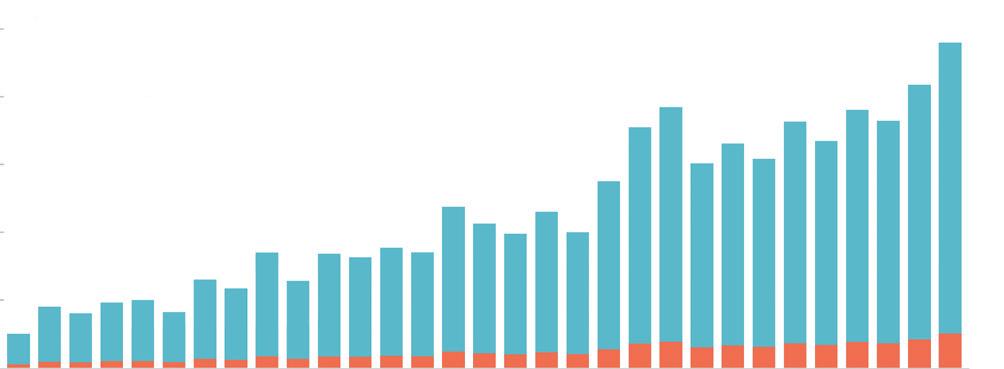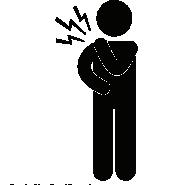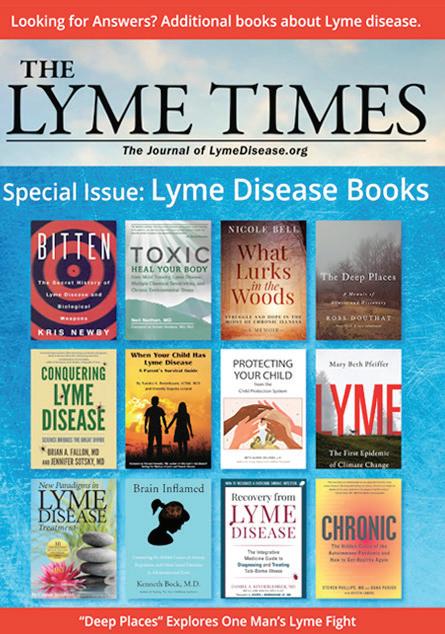

Source of data
The data in this report was collected between September 23 and December 1, 2021 and consists of self-reported data from 155 clinicians who treat persistent or chronic Lyme disease.
Suggested Citation
Johnson, Lorraine; Janicki, Sylvia (2022): Access to Care in Lyme Disease: Clinician Barriers to Providing Care Chartbook. figshare. Book. https://doi.org/10.6084/ m9.figshare.21321195
This report can be downloaded at https://www.lymedisease.org/mylymedata-clinicianlyme-survey-report

Conflict of Interest
The authors declare no conflict of interest.
Support
Funding for this work is supported in part by grants from the Bruce Lindorf Memorial Foundation, and the BMC Foundation. The funders had no role in study design, data collection and analysis, decision to publish, or preparation of the manuscript.
Special Acknowledgments
We thank Dr. Elizabeth Maloney for her work on the published study and the physicians who participated in the study. We would also like to thank Melissa Wright, Dorothy Leland, Carolyn Degnan, Lisa Klepper, Laurie Martin, and Mira Shapiro for helping make the survey a success and providing thoughtful comments and design efforts.
Additional Resources
The published study can be found here: Johnson, L.B.; Maloney, E.L. Access to Care in Lyme Disease: Clinician Barriers to Providing Care. Healthcare 2022, 10, 1882. https://doi.org/10.3390/healthcare10101882
To enroll in MyLymeData, visit www.MyLymeData.org
For more information about findings from the registry, visit the MyLymeData Viz Blog at https://www.lymedisease.org/mylymedata-viz-blog/
1 Table of Contents About LymeDisease.org Introduction Clinician Survey Clinician Respondents Supply and Demand Crisis Limited Availability of Care Diagnostic and Treatment Delays Challenges of Providing Care Administrative Burdens Clinicians Face Treating A Marginalized Illness Economics of Providing Care ............................................ 14-15 ........................................ 12-13 ......................................... 8-9 ................................... 11 ................................................. 10 ........................................................ 7 ........................................................ 6 .............................................................. 5 ........................................................................ 4 ............................................................................ 3 .......................................................... 2
About LymeDisease.org
About LymeDisease.org
MyLymeData Publications
About MyLymeData
LymeDisease.org is one of the oldest Lyme disease 501(c)(3) nonprofit organizations in the nation. For over 30 years we have worked to make the patient voice stronger, to support patient-centered research, to promote legislative change, and to create a future where Lyme disease patients can receive the treatments they need to get well. We do this through patient empowerment and science-based advocacy—a powerful combination. MyLymeData is a patient registry and research platform that was developed and launched by LymeDisease.org in 2015. It uses big data research tools that allow patients to quickly and privately pool their data to determine which treatments work best. The registry includes over 17,000 patients enrolled from every state. To enroll in MyLymeData, visit www.MyLymeData.org. For more information about findings from the registry, visit the MyLymeData Viz Blog at www.lymedisease.org/mylymedata-viz-blog
This survey is part of a series of surveys conducted by LymeDisease.org over the past ten years. To find out more about LymeDisease.org surveys, contact the lead author, Lorraine Johnson, JD, MBA at lbjohnson@ lymedisease.org.
Johnson, L.B.; Maloney, E.L. Access to Care in Lyme Disease: Clinician Barriers to Providing Care. Healthcare. 2022; 10, 1882. https://doi.org/10.3390/ healthcare10101882
Johnson, L.B.; Shapiro, M.; Mankoff, J. Removing the Mask of Average Treatment Effects in Chronic Lyme Disease Research Using Big Data and Subgroup Analysis. Healthcare. 2018; 6(4):124. Available from: http://www. mdpi.com/2227-9032/6/4/124
Johnson, L.B. Stigma and Privacy in Lyme Disease [Preprint]. 2019. https://doi.org/10.6084/ m9.figshare.7704167
Johnson, L.B.; Aylward, A.; Stricker, R.B. Healthcare Access and Burden of Care for Patients with Lyme Disease: a Large United States Survey. Health Policy. 2011 Sep; 102(1):64-71. Epub 2011 Jun 14. https://doi.org/10.1016/j.healthpol.2011.05.007
Johnson, L.B.; Wilcox, S.; Mankoff, J.; Stricker, R.B. Severity of Chronic Lyme Disease Compared to Other Chronic Conditions: A Quality of Life Survey. PeerJ 2015; https://doi.org/10.7717/peerj.322
Johnson, L.B.; Shapiro, M.; Stricker, R.B.; Vendrow, J.; Haddock, J.; Needell, D. Antibiotic Treatment Response in Chronic Lyme Disease: Why Do Some Patients Improve While Others Do Not? Healthcare 2020; 8, 383. https://doi.org/10.3390/healthcare8040383
Vendrow, J.; Haddock, J.; Needell, D.; Johnson, L.B. Feature Selection from Lyme Disease Patient Survey Using Machine Learning. Algorithms. 2020; 13(12):334. https://doi.org/10.3390/a13120334
2
500,000

CDC estimates 476,000 cases per year
Data Source: Derived from Bay Area Lyme Foundation (based on CDC surveillance statistics)
Lyme disease is caused by the spirochete Borrelia burgdorferi and is primarily transmitted to humans by blacklegged Ixodes deer ticks. It accounts for 95% of all cases of vector-borne disease in the U.S., with an estimated 476,000 new cases per year (Kugeler 2021, Schwartz 2021). If diagnosed and treated early, the majority of Lyme disease cases resolve without complications. Even with early diagnosis
and treatment, up to 44% have been reported to fail treatment, with only 56% considered to have returned to health (Aucott 2022). In this white paper, we refer to patients who have been diagnosed with Lyme disease by a clinician and who remain ill six or more months following antibiotic treatment as having persistent or chronic Lyme disease (PLD/ CLD).
Persistent or Chronic Lyme Disease Definition
Patients who have been clinically diagnosed with Lyme disease, treated with antibiotics, and remain ill six or more months following treatment.
3
Introduction
400,000 300,000 200,000 100,000
CDC
CDC-Estimated Total Diagnosed
0 1988 1990 1992 1994 1996 1998 2000 2002 2004 2006 2008 2010 2012 2014 2016 2018
Number of
Reported Cases
Cases
Clinician Survey
“Lyme is a disease that we are just scratching the surface on. So many people have it, but cannot afford care.”
- Clinician Respondent
PLD/CLD patients face various challenges to accessing care, including insurance coverage, expenses, travel time, and availability. Some cannot find local physicians to treat them, and many report that their care is not covered by insurance. LymeDisease.org has surveyed patients about access to care in the past and published white papers and peer-reviewed articles (Johnson 2011; Johnson 2020).
Policy decisions about health care often focus on how important the patient’s story is, but the clinician’s story is often forgotten. The purpose of this study was to identify the challenges that clinicians who care for patients with PLD/CLD face, as well as information about their professional qualifications and experience in treating PLD/CLD. To our knowledge, this is the first survey conducted of clinicians who treat PLD/CLD on this topic.

4
Clinician Respondents
Between September 23 and December 1, 2021, LymeDisease.org surveyed U.S. clinicians who treat PLD/CLD patients. The survey was distributed via email and through its physician referral program. The questionnaire included 30 multiple choice items and one open text question asking for additional comments. The results of the survey were published in a peer reviewed journal earlier this year (Johnson, 2022).
Professional Certification
155 clinicians from 30 states responded to survey. 55% MD/DO
15% ND with prescription privilege
12% Nurse practitioner
Clinicians have extensive experience treating PLD/CLD patients. Most have treated more than 500 patients and 38% have treated more than 1,000.
How many patients with Lyme disease have you treated in your career?
The majority dedicate more than half of their practice to Lyme disease and 19% treat Lyme disease and other tick-borne infections exclusively. Clinicians report the percentage of patients in their current practice as indicated below:
How many patients with Lyme disease are you currently treating?
5
>300 patients 100-300 patients <100 patients 28% 35% 37% have treated more than 500 patients 56% < 100 patients > 1000 patients 100-500 patients 17% 38% 27% 500-1000 patients 18%
A Supply and Demand Crisis
“We need many more clinicians educated to recognize this problem earlier, treat more often, and help more people.”
- Clinician Respondent
Clinicians’ responses to this survey highlight the challenges and hurdles that they face in providing care to PLD/CLD patients. Fundamentally, the responses paint a picture of structural barriers that are difficult for clinicians to surmount and that disincentivize others from entering the field. This has created a shortage of PLD/CLD providers.
At the same time, demand for PLD/CLD providers has grown. Although the exact number of patients with PLD/CLD is unknown, it’s likely these cases increase in lockstep with cases of acute Lyme disease—which have risen dramatically over the past decade. New PLD/CLD cases stem largely from
patients who remain ill after standard treatment, despite early diagnosis, and from patients who are diagnosed later in the course of their disease, when conventional treatments fail more frequently (Aucott 2013, Asch 1994, Hirsch 2018, Shadick 1994, Shadick 1999, Trieb 1998).
The shortage of clinicians who treat PLD/CLD together with increasing patient demand for care as PLD/CLD cases rise, has created a supply-demand chain crisis that currently has no solution and urgently needs to be addressed. Clinicians identified reasons why they are reluctant to treat PLD/CLD in the chart below.
Why we don’t have enough Lyme
Electing to treat a marginalized disease
Mastery of the subject matter
Diagnostic and therapeutic uncertainty
Lack of professional support
Disease clinicians:
6
85% 74% 72% 51%
Limited Availability of Care
The current supply of clinicians is insufficient to meet patient demand for care. This causes delays in initial consultations and forces many patients to travel outside their state to receive care.
Clinicians report that only 37% of patients are able to book an appointment with their practice within one month for an initial consultation, 33% wait 1-2 months, 19% wait 2-4 months, 8% wait longer than
4 months, and 4% of clinicians are not accepting new patients.
Out of state patients are common. 38% of clinicians report that more than twenty-five percent of their practice consists of patients from out of their state of practice. The length of delays for an initial consultation are reflected in the figure below.
How long do Lyme patients wait for their first visit?
7
< 1 month 1-2 months 2-4 months 4-6 months >6 months not accepting new patients 37% 33% 19% 3% 5% 4% 60%
more than a month for initial consultation
report patients wait
Diagnostic and Treatment Delays
One clinician described the major challenge to treating Lyme disease as the ”lack of medical school curriculum on TBD and other vectorborne diseases”.
Diagnostic and treatment delays increase the probability that patients will develop PLD/CLD and complicate care. Educational efforts aimed at addressing these problems could reduce the rise in cases of PLD/CLD.
In addition to increasing the number of clinicians available to treat, reducing the number of Lyme disease patients who develop PLD/CLD by reducing diagnostic delays is essential.

8
Asked to identify the primary source of diagnostic delays, clinicians cited inadequate physician education about tick-borne diseases, falsely negative lab tests, and prior misdiagnosis.
Both clinicians and patients have identified misdiagnosis as a major source of treatment delays.
Nearly three-quarters (72%) of patients report being initially misdiagnosed. Reasons identified by clinicians for diagnostic delays are included in the chart below.
Reasons for delayed Lyme disease diagnosis:
Inadequate physician education about tick-borne disease
False negative lab test
Prior misdiagnosis
Lack of EM rash
Patient resided in state considered low incidence
First disease manifestation associated with late disease
Public misinformation about disease risk
Patient delayed seeking care





9
86% 61% 52% 37% 25% 21% 16% 5%
Challenges to Providing Care
“Lyme disease is the hardest diagnosis I treat, as each patient responds so differently to therapy. It is hard to know where to start with each one, what will work, what will make them worse, etc. Some just never seem to get better no matter what I do. It is gratifying to see others improve.”
- Clinician Respondent
In the survey, clinicians identified as professional obstacles to providing care diagnostic and therapeutic uncertainty and mastery of a practice that involves highly complex care that must be individualized.
Why treating Lyme disease is hard:
Complexity of care
Patients inability to pay out-ofpocket costs
Lack of professional support
Physician organizations’ opposition to the treatment of CLD
Cognitive impairment of patients
Frequent patient calls between scheduled appts
As the chart below reflects, providing. care for PLD/CLD patients is challenging for many reasons including complexity of care, reimbursement issues, and length of patient visits.
10
Reimbursement for care Length of visits 79% 75% 59% 61% 57% 49% 34% 31%
Administrative Burdens Clinicians Face

I find the hardest problem treating these patients is that it takes so much time and energy- the reimbursement is inadequate. I only do this because I am passionate about it.”
Clinicians also report many administrative burdens related to insurance, including burdens associated with obtaining prior authorizations and approval for diagnostic testing.
Insurance make it hard to treat Lyme disease:
Prior authorizations for medications
Insurer denial of diagnostic testing for tick-borne diseases from specialty labs
Lack of FDA-approved drugs for the treatment of advanced cases of tick-borne diseases
Other insurance related burdens
Being excluded from participating in an insurance network because of treating Lyme disease
11 77% 71% 54% 49% 11%
“
Treating a Marginalized Illness
“While my patients are generally very supportive, some of my colleagues have stopped speaking to me and I worry about the medico-legal repercussions of what I do.”
- Clinician Respondent
Unlike most health care, PLD/CLD clinicians provide care for a disease that is frequently misunderstood and marginalized. They also are professionally stigmatized, lack professional support from colleagues, and operate under a high threat of medical board actions.
The heightened professional threat to treating clinicians is illustrated by the fact that other recognized
institutions outside the community diagnose, but refuse to treat.
Clinicians report that providing care is more difficult because of stigma they experience and their exposure to state medical board liability as well as insurance and hospital investigations. 75% report having been stigmatized or treated disrespectfully by professional colleagues because they treat Lyme disease.
I am anxious about being identified and called out by my colleagues but I feel I must treat patients because so many suffer and cannot find the care they need. I started treating about a year ago, before that I was just diagnosing and referring out. Now Cleveland Clinic refers to me. They diagnose but decline to treat!”
of clinicians who treat PLD/CLD have felt stigmatized or disrespected by professional colleagues because they treat Lyme disease.
12
75% “

Regulatory and legal challenges are not uncommon. Remarkably, 39% report having been either reported to a medical board, an insurer, or subjected to a hospital-based quality improvement inquiry. One clinician explained how legal threats as well as
potential targeting of their practice by insurers led to moving to another state. The chart below shows the types of actions clinicians have been threatened with as a result of treating PLD/CLD.
Being reported for treating Lyme disease
Subjected to a medical board inquiry
Reported to a medical board by a medical colleague
Reported to a third-party payer/insurer
Reported to a medical board by a patient
Reported to a medical board by an anonymous complaint
Reported to a medical board by an insurer
Subjected to a hospital-based quality improvement inquiry involving Lyme disease
39% of clinicians report having been reported to a medical board, an insurer, or subjected to a hospital-based quality improvement inquiry

I used to practice in a state where physicians who treat complex patients, including people with chronic Lyme, were specifically targeted by health insurance companies for medical board complaints and other attacks ESPECIALLY WHEN THEY HELPED PATIENTS OTHER DOCTORS GAVE UP ON. Eventually I elected to move to [a state] where there is less interruption of care and more protection of vulnerable patients from predatory insurance entities.”
13
19% 12% 11% 11% 10% 5% 4%
“
Economics of Providing Care
“I think the most difficult problem is the cost of providing this amount of complex care on a cash basis. To really review hundreds of records, spend time with the patient and do a proper workup, takes hours. I'd like to see more support for patients and clinicians who chose to help this set of patients.”
-
Clinician Respondent
Clinicians report that the economic model for treating Lyme disease is broken and many clinicians instead provide services on a cash basis. Primary care physician shortages and cost issues are sometimes addressed through use of non-physician teams (e.g. nurses and physician assistants). However, one clinician observed that given the length of office visits and the need to adequately staff a PLD/CLD, their ability to make their own payday was frequently sacrificed.
“It is not surprising then that clinicians identify the ability of patients to pay out-of-pocket as a major challenge to providing care. The administrative burdens of prior authorizations for medications and handling insurance denials for specialty diagnostic testing also increase the difficulties clinicians face.
This patient population requires exponentially more care and attention than the typical patient. I knew that at some point I would be forced to stop taking insurance and move forward on a cash pay only basis. Looking at the numbers, taking commercial insurance for these patients just doesn’t make any sense. I believe that the main issue that causes many of these patients to be without access to care is the amount they need to spend on their practitioners plus the out-of-pocket costs for out of network testing, labs, and treatment. For most of these patients that is anywhere from $10 to $20K per year. It is a huge burden”
14
Huge overhead costs due to the large amount of staff and large space to accommodate it all drives fees to astronomical heights. I have had many payless paydays but to the patients who see high fees, and the public and non-Lyme docs, they think I am getting rich and care is overpriced. I am in solo practice, have 9 employees but I do not do any costly medical or surgical procedures to pay the bills. And since I can only see ten patients or less a day, cash flow is often inadequate to pay the bills”
One way clinicians can avoid targeting by insurance companies is by not participating in insurance networks. Most respondents indicated that they do not participate in insurance networks or participate in Medicare or Medicaid. Less than a quarter of PLD/CLD clinicians report billing insurers directly. In addition, clinicians point out that the traditional economic model of care in medicine, which relies heavily on insurance coverage for compensation, working in-network, with short patient consultations does not work in the context of PLD/CLD. This is because the complex nature of the care needed by PLD/CLD patients requires longer treatment consultations that do not fit with an insurance based practice. Acceptance of insurance by clinicians was limited, with roughly three quarters of clinicians saying that they did not participate in insurance networks (74%) or directly bill insurers (76%). As described in the figure below, 77% do not participate in Medicare, Medicaid, or other government supported plans.
77% of clinicians do not participate in Medicare, Medicaid, or other government supported plans.
15
Medicare Medicaid Other government support plans None of the above 21% 12% 6% 77%
Do you have hospital privileges? Do you participate in insurance? 15% YES 26% YES 85% NO 74% NO “
References
Asch, E.S.; Bujak, D.I.; Weiss, M.; Peterson, M.G.; Weinstein, A. Lyme Disease: An Infectious and Postinfectious Syndrome. J. Rheumatol. 1994, 21, 454–461.
Aucott, J.N.; Rebman, A.W.; Crowder, L.A.; Kortte, K.B. PostTreatment Lyme Disease Syndrome Symptomatology and the Impact on Life Functioning: Is There Something Here? Qual. Life Res. 2013, 22, 75–84.
Hirsch, A.G.; Herman, R.J.; Rebman, A.; Moon, K.A.; Aucott, J.; Heaney, C.; Schwartz, B.S. Obstacles to d] Diagnosis and Treatment of Lyme Disease in the USA: A Qualitative Study. BMJ Open. 2018, 8, e021367.
Kugeler, K.J.; Schwartz, A.M.; Delorey, M. et al. Estimating the Frequency of Lyme Disease Diagnoses —United States, 2010-2018. Emerg Infect Dis. 2021, 27(2).
Johnson L.; Aylward, A.; Stricker, R.B. Healthcare Access and Burden of Care for Patients with Lyme Disease: A Large United States Survey. Health Policy. 2011 Sep,102(1):64-71. Available from: http://www.ncbi.nlm. nih.gov/pubmed/21676482.
Johnson, L.B.; Maloney, E.L. Access to Care in Lyme Disease: Clinician Barriers to Providing Care. Healthcare 2022, 10, 1882. https://doi.org/10.3390/ healthcare10101882
Johnson, L.; Shapiro, M.; Stricker, R.B.; Vendrow, J.; Haddock, J.; Needell, D. Antibiotic Treatment Response
in Chronic Lyme Disease: Why Do Some Patients Improve While Others Do Not? Healthcare 2020, 8, 383. https:// doi.org/10.3390/healthcare8040383.
Johnson, L.B. Outcomes Important to Lyme Patients: Results of a LymeDisease.org Patient Survey conducted in 2015. figshare. Book. 2020. https://doi.org/10.6084/ m9.figshare.10010534.v1
Shadick, N.A.; Phillips, C.B.; Logigian, E.L.; Steere, A.C.; Kaplan, R.F.; Berardi, V.P.; Duray, P.H.; Larson, M.G.; Wright, E.A.; Ginsburg, K.S.; et al. The Long-Term Clinical Outcomes of Lyme Disease: A Population-Based Retrospective Cohort Study. Ann. Intern. Med. 1994, 121, 560–567.
Shadick, N.A.; Phillips, C.B.; Sangha, O.; Logigian, E.L.; Kaplan, R.F.; Wright, E.A.; Fossel, A.H.; Fossel, K.; Berardi, V.; Lew, R.A.; et al. Musculoskeletal and Neurologic Outcomes in Patients with Previously Treated Lyme Disease. Ann. Intern. Med. 1999, 131, 919–926.
Schwartz, A.M.; Kugeler, K.J.; Nelson, C.A. et al. Use of Commercial Claims Data for Evaluating Trends in Lyme Disease Diagnoses, United States, 2010-2018. Emerg Infect Dis. 2021; 27(2).
Treib, J.; Fernandez, A.; Haass, A.; Grauer, M.T.; Holzer, G.; Woessner, R. Clinical and Serologic Follow-Up in Patients with Neuroborreliosis. Neurology 1998, 51, 1489–1491.

16




17
The Lyme Times connects you to trustworthy information about critical research, events and treatment for Lyme and other tick-borne diseases. Help us advocate for change, raise awareness, and fund research that can improve patient’s lives. Visit LymeDisease.org Become a member today Lyme Times LymeDisease.org’s Member Community is THE one place to refer anyone wanting to get accurate info about Lyme Disease. It's now more like an authority that people go to other than the CDC. We need to support you in order to keep all the issues regarding this disease relevant in the minds of all. " — Patient “ [ ]
Authority on Lyme




18 Visit MyLymeData.org The largest study of chronic Lyme keeps growing. 17,000 today. Join now to help us reach 20,000!























